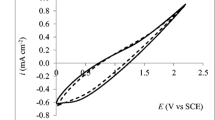Abstract
The generation of active chlorine on Ti/Sn(1−x)Ir x O2 anodes, with different compositions of Ir (x = 0.01, 0.05, 0.10 and 0.30 ), was investigated by controlled current density electrolysis. Using a low concentration of chloride ions (0.05 mol L−1) and a low current density (5 mA cm−2) it was possible to produce up to 60 mg L−1 of active chlorine on a Ti/Sn0.99Ir0.01O2 anode. The feasibility of the discoloration of a textile acid azo dye, acid red 29 dye (C.I. 16570), was also investigated with in situ electrogenerated active chlorine on Ti/Sn(1−x)Ir x O2 anodes. The best conditions for 100% discoloration and maximum degradation (70% TOC reduction) were found to be: NaCl pH 4, 25 mA cm−2 and 6 h of electrolysis. It is suggested that active chlorine generation and/or powerful oxidants such as chlorine radicals and hydroxyl radicals are responsible for promoting faster dye degradation. Rate constants calculated from color decay versus time reveal a zero order reaction at dye concentrations up to 1.0 × 10−4 mol L−1. Effects of other electrolytes, dye concentration and applied density currents also have been investigated and are discussed.











Similar content being viewed by others
References
Brasil (2004) Portaria 518, Ministério da Saúde, issued in 03/25/2004 and published in DOU Executivo in 03/26/2004
Xie YF (2004) Disinfection byproducts in drinking water, formation, analysis and control. CRC Press LLC
Burney HS (1993) In: White RE, Conway BE, Bockris JOM (eds) Modern aspects in electrochemistry. Plenum Press, New York, p 393
Rudolf M, Rousar I, Krysa J (1995) J Appl Electrochem 25:155
Rengarajan V, Sozhan G, Narasimham KC (1996) Bull Electrochem 12:327
Casson LW, Bess JW Jr (2003) Conversion to on-site sodium hypochlorite generation, water and wastewater application. CRC Press LLC
Kraft A, Stadelmann M, Blaschke M, Kreysig D, Sandt B, Schroder F, Rennan J (1999) J Appl Electrochem 29:861
Kraft A, Blaschke M, Kreysig D, Sandt B, Schroder F, Rennan J (1990) J Appl Electrochem 29:895
Patermarakis G, Fountoukidis E (1990) Water Res 24:1491
Schoberl M (1991) Eur Pat EP 0 515 628 B1
Kanekuni N, Shono N, Kyohara M, Tabata K, Kono S, Hayakawa M (1995) Eur Pat Appl EP 0 711 730 AL
Ibl N, Vogt H (1981) In: Bockris JOM, Conway BE, Yeager E, White RE (eds) Comprehensive treatise of electrochemistry, vol 2. Plenum Press, New York, p 167
Bennett JE (1974) Chem Eng Prog 70:60
Arikado T, Iwakura C, Tamura H (1978) Electrochim Acta 23:9
Harrison JA, Hermijanto AD (1987) J Electroanal Chem 225:159
Do JS, Yeah WC (1995) J Appl Electrochem 251:483
Czarnetzki LR, Janssen LJJ (1992) J Appl Electrochem 22:315
Do JS, Yeah WC, Chao IYa (1997) Ind Eng Chem Res 36:349
Rudolf M, Rousar I, Krysa J (1995) J Appl Electrochem 25:155
Trasatti S (1984) Electrochim Acta 29:1503
Mozota J, Conway BE (1991) J Electrochem Soc 128:2142
Snoeyink VL, Jenkins D (1980) Water chemistry. John Wiley & Sons, New York, p 386
Stum W, Morgan JJ (1996) Aquatic chemistry, 3rd edn. John Wiley & Sons, New York, Chap. 8, p 490
Callaway JO (1989) In: Clesceri LS, Greenberg AE, Trussel RR (eds) Standard methods for the examination of water and wastewater, 17th edn. Alpha Awwa-WPCF, Washington, DC, Part 4000, p 62
Spyrkowicz L, Kaul SN, Neti RN, Satyanarayan S (2005) Water Res 39:1601
Spyrkowicz L, Radaelli M, Daniele S (2005) Catal Today 100:425
Vlyssides AG, Loizidou M, Karis PK, Zorpas AA, Papaioannou D (1999) J Hazard Mater B70:41
Comninellis Ch, Pulgarin C (1993) J Appl Electrochem 23:108
Comninellis Ch (1994) Electrochim Acta 39:1857
Fugivara PTA, Cardoso AA, Benedetti AV (1996) Analyst 121:541
Iwakura C, Sakamoto K (1985) J Electrochem Soc 132:2420
Carneiro PA, Osugi ME, Fugivara CS, Borale N, Zanoni MVB (2005) Chemosphere 59:431
Hepel M, Luo J (2001) Electrochim Acta 47:729
Zollinger H (1991) Color chemistry: syntheses, properties and applications of organic dyes and pigments, 2nd edn. V.C.H. Publishers, New York
Forti JC, Olivi P, Andrade AR (2004) J Electrochemical Soc 150:E222
Ortiz PI, De Pauli CP, Trasatti S (2004) J New Mater Electrochem Syst 7:153
Vogel AI (1995) Qualitative analytical chemistry, 5th edn. Mestre Jou Publishers, São Paulo, p 419
Cachet H, Zenia F, Froment M (1999) J Electrochem Soc 146:977
Acknowledgements
The authors thank Dr. Walt Zeltner of the University of Wisconsin for English language revision of this paper and acknoledge financial support from Brazilian funding agencies CAPES, CNPq and FAPESP.
Author information
Authors and Affiliations
Corresponding author
Rights and permissions
About this article
Cite this article
Oliveira, F.H., Osugi, M.E., Paschoal, F.M.M. et al. Electrochemical oxidation of an acid dye by active chlorine generated using Ti/Sn(1−x)Ir x O2 electrodes. J Appl Electrochem 37, 583–592 (2007). https://doi.org/10.1007/s10800-006-9289-6
Received:
Accepted:
Published:
Issue Date:
DOI: https://doi.org/10.1007/s10800-006-9289-6




